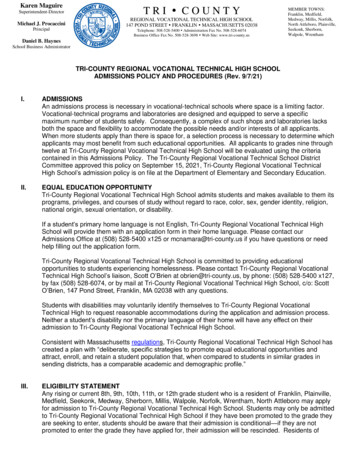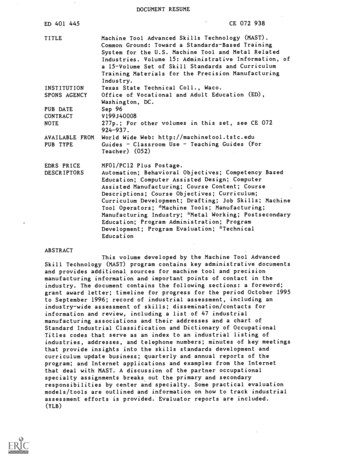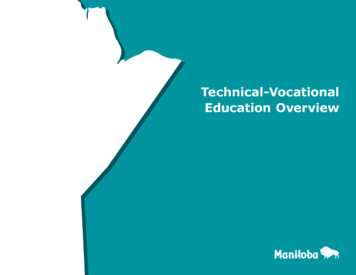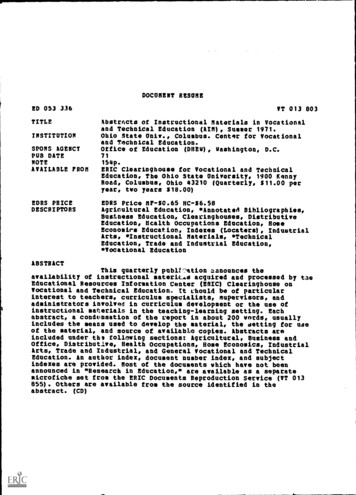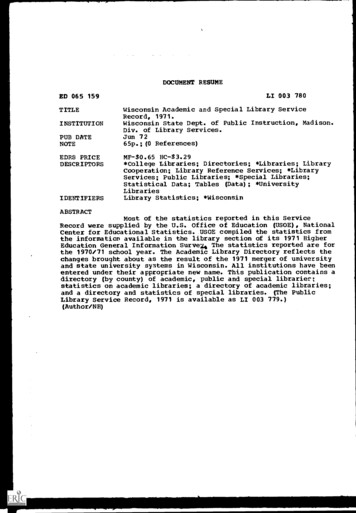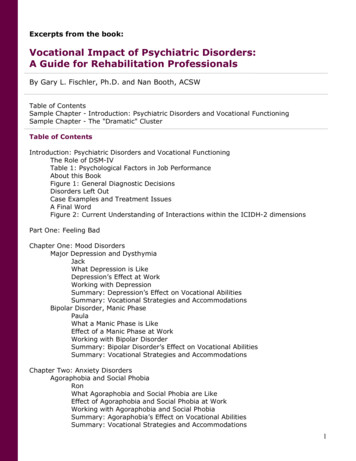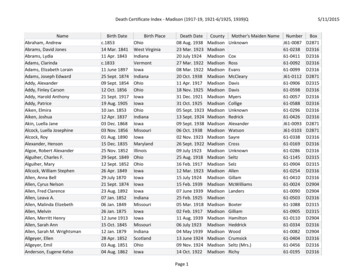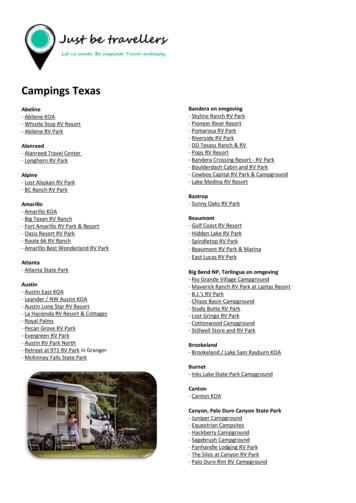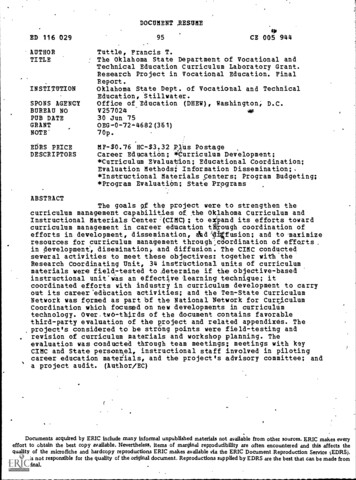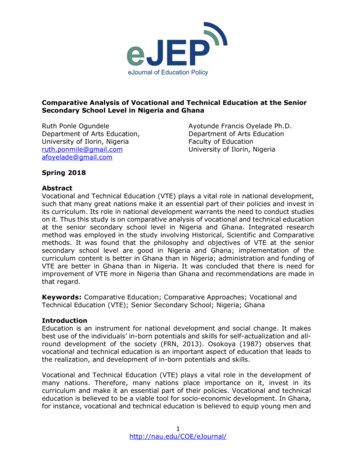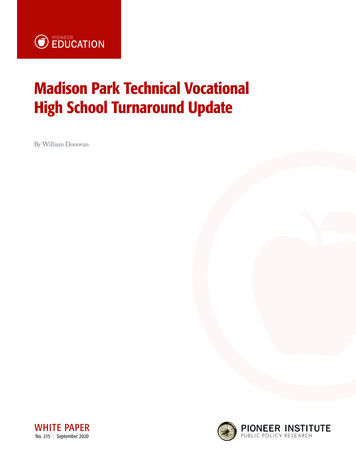
Transcription
Madison Park Technical VocationalHigh School Turnaround UpdateBy William DonovanWHITE PAPERNo. 215 September 2020
MISSIONPioneer Institute develops and communicates dynamic ideas that advanceprosperity and a vibrant civic life in Massachusetts and beyond.VisionValuesSuccess for Pioneer is when the citizens ofour state and nation prosper and our societythrives because we enjoy world-class optionsin education, healthcare, transportation andeconomic opportunity, and when our governmentis limited, accountable and transparent.Pioneer believes that America is at itsbest when our citizenry is well-educated,committed to liberty, personal responsibility,and free enterprise, and both willing andable to test their beliefs based on facts andthe free exchange of ideas.This paper is a publication of Pioneer Education,which seeks to increase the education options availableto parents and students, drive system-wide reform, andensure accountability in public education. The Center’swork builds on Pioneer’s legacy as a recognized leader inthe charter public school movement, and as a championof greater academic rigor in Massachusetts’ elementaryand secondary schools. Current initiatives promotechoice and competition, school-based management, andenhanced academic performance in public schools.Pioneer Health seeks to refocus the Massachusettsconversation about health care costs away fromgovernment-imposed interventions, toward marketbased reforms. Current initiatives include drivingpublic discourse on Medicaid; presenting a strongconsumer perspective as the state considers a dramaticoverhaul of the health care payment process; andsupporting thoughtful tort reforms.Pioneer Public seeks limited, accountable governmentby promoting competitive delivery of public services,elimination of unnecessary regulation, and a focuson core government functions. Current initiativespromote reform of how the state builds, manages,repairs and finances its transportation assets as wellas public employee benefit reform.Pioneer Opportunity seeks to keep Massachusettscompetitive by promoting a healthy business climate,transparent regulation, small business creation in urbanareas and sound environmental and development policy.Current initiatives promote market reforms to increasethe supply of affordable housing, reduce the cost ofdoing business, and revitalize urban areas.Pioneer Institute is a tax-exempt 501(c)3 organization funded through the donations of individuals, foundations and businesses committed to the principles Pioneer espouses. To ensure its independence,Pioneer does not accept government grants.
MADISON PARK TECHNIC AL VOC ATIONAL HIGH SCHOOL TURNAROUND UPDATETable of ContentsExecutive Summary 4Background 5The turnaround plan 7What’s changing? 8MCAS Prep 10Credits for college 11The Lynn Tech turnaround: it starts at the top 12Summary 13Recommendations 133
MADISON PARK TECHNIC AL VOC ATIONAL HIGH SCHOOL TURNAROUND UPDATEExecutive SummaryMadison Park Technical Vocational High School in Boston is attempting a turnaround and hasbeen for decades. In 2016, after having been designated a Level 4 school by the MassachusettsDepartment of Elementary and Secondary Education (DESE), a stamp that branded it “underperforming,” school officials created a plan they began implementing in June of that year.It was a 111-page document that included a stark look at recent poor practices at the 43-yearold school, along with some of its unique challenges. More importantly it included a strategyto change the culture at Madison Park, stimulate academic improvement, provide more professional support for teachers, and reverse rising dropout and falling graduation rates, among otherobjectives.Since the new plan began, some signs of improvement have appeared. The graduation rate,which was 57 percent in 2017, was above 68 percent in 2019. The dropout rate, once above 6 percent, is now under 5 percent. Enrollment, which tumbled by half from 2005 to 2017, has climbedmore than 17 percent in the past three years.Advanced instruction has emerged as a strong point for the school. Dual enrollment partnerships with several local colleges have enabled many Madison Park students to earn college creditsbefore graduating. In 2020, two students earned their associate’s degrees.Early results of the turnaround project have been recognized by the New England Association of Schools and Colleges (NEASC). In late 2018 NEASC, a regional education accreditationassociation, reported in the evaluation it conducts of schools every 10 years, that Madison Park was“poised to establish itself as an institution of first-class learning.”If so, it would be a significant comeback. Despite the encouraging indicators, the school stilltrails other vocational technical schools in the state in academics. Its Massachusetts Comprehensive Assessment System (MCAS) scores rank at or near the bottom in all categories. It is the worstperformer among them in terms of graduation and dropout rates, trailing the statewide average inthose categories among vocational technical schools by large margins.The attempted turnaround is also happening at a time when Boston Public Schools (BPS) isunder fire. In March the DESE released a highly critical review of the system. It concluded thatstudents in the district faced transportation problems, poor facilities, excessive leadership turnover, considerable disparities in access to resources, and “systemic disarray” of special educationservices.1Madison Park has struggled with frequent leadership turnover. Between 2010 and 2015 theschool had five different headmasters. Another headmaster was removed in May of 2020 as part ofa citywide shake-up among school administrations. At the same time it was announced that KevinMcCaskill, the executive director for the past five years who has led the turnaround effort, wouldbe moving to the BPS central office to assume broader responsibilities. However, he has remainedexecutive director and interim headmaster until a permanent headmaster is hired.Each new principal has brought new priorities and approaches, interrupting continuity inplanning and effort. In particular, after a much-heralded Innovation Plan was approved in 2012,BPS invested more than 1 million in technology, textbooks and vocational-technical materials.2But as leadership changed support for the plan waned.The challenges for Madison Park go beyond the headmaster’s office. Demographics have beena major factor in the school’s academic results. About 94 percent of students are students of color(57 percent Latino, 37 percent Black). During the 2019-2020 school year, 92 percent of the 1,021students enrolled at Madison Park were classified as “high needs.” That was second only to Boston International High School, a college preparatory school designed to teach students English,including a program for students newly arrived in the U.S. who have little or no schooling in theirhome country or whose education has been interrupted.In the 2018–2019 school year, 73.1 percent of Madison Park’s students were considered economically disadvantaged, the highest among vocational-technical schools in the state. Roughly35 percent were English Language Learners, again the highest among voc-tech schools, and 30.64Since the new planbegan, some signsof improvementhave appeared. Thegraduation rate, whichwas 57 percent in 2017,was above 68 percent in2019. The dropout rate,once above 6 percent, isnow under 5 percent.In the 2018–2019school year, 73.1percent of MadisonPark’s students wereconsidered economicallydisadvantaged,the highest amongvocational-technicalschools in the state
MADISON PARK TECHNIC AL VOC ATIONAL HIGH SCHOOL TURNAROUND UPDATEpercent had disabilities, according to DESE. Absenteeism remains high, with 47 percent of thestudents missing 10 percent or more of school days in 2018–2019.Those numbers certainly contribute to underperformance at urban college preparatory highschools. But they are more of a factor at urban vocational-technical schools. There, students whoare English Language Learners must often negotiate textbooks that are more exacting and precisethan college textbooks, creating a greater need for remedial services.Demographics can create a difficult apples-to-oranges comparison when Madison Park iscompared with schools whose enrollment includes fewer minority students and more studentsfrom higher income backgrounds. Many of the top performing voc-tech schools in Massachusettsare in upper-income suburban communities or rural areas.Still, other urban vocational technical schools, such as Lynn Vocational Technical Institute andthe Roger L. Putnam Vocational Technical Academy in Springfield, where McCaskill previouslyled reforms, have large minority, low-income, English Language Learner populations, and havemanaged to raise academic scores and graduation rates, while also seeing a decline in dropouts.The question then is this: can Madison Park play a larger role in creating educational andeconomic opportunity in Boston by providing needed skilled labor for Boston-based businesses?As noted, McCaskill was the principal at Putnam when it began its turnaround. But he sayshe’s aiming higher than Putnam or Lynn Tech and wants to outperform top Massachusetts voctech schools such as Blackstone Valley Regional Vocational Technical High School in Uptonand Assabet Valley Regional Technical High School in Marlborough, two communities that aredistinctly different from Boston. At Blackstone Valley 0.2 percent of the students are EnglishLanguage Learners. At Assabet Valley, more than 78 percent of the students are white.“I compare our data against what I consider the best vocational system in the country,” saysMcCaskill. “We’re behind with respect to performance of students. But that’s the only way youcatch up. Compare yourself to the best. Even though their demographics are nowhere near ours,nowhere near it, those are the schools we want to be compared to.” 3BackgroundIn the past 20 years there has been a resurgence of interest in career vocational-technical education. States have more than 100 new laws, policies, and regulations related to vocational education, many of which increased state funding for such programs.4 Many vocational educationexperts consider Massachusetts’ CVTE system, with its unique approach of alternating educational focus—one week spent in the classroom on academics, the next focused on career technicalskills—a role model.A 2015 University of Connecticut study found that full-time vocational technical schools inMassachusetts (as opposed to college preparatory high schools that embed some vocational-technical courses within their curriculum) successfully promote improved graduation rates and lowerdropout rates.5Other reports have found that students who received vocational-technical training scoredhigher on math exams, for example. Also, attendance and graduation rates at CVTE schools weregenerally above 90 percent and there were particularly strong benefits for low-income students.6Together, they speak to the reputation that CVTE schools are developing as places where studentscan graduate equipped with practical skills and preparation for higher education.Madison Park Technical Vocational High School, in the Roxbury neighborhood of Boston, isa grades 9–12 high school, with more than 1,000 students in the 2019–2020 school year. It is theonly school in Boston that exclusively prepares its students for careers and postsecondary educationupon graduation. It offers training in 20 technical vocational programs, including AutomotiveTechnology, Dental Assisting, Graphic Communications, Culinary Arts, Carpentry, Programingand Web Development. During their freshman year, students explore all programs and select aconcentration. All students rotate their schedule every other week. Freshmen and sophomoresalternate one full week of academic courses with a week in which they spend half of each day inCVTE. Juniors and seniors rotate a full week of academic courses with a week of full-time CVTE.5The question then isthis: can Madison Parkplay a larger role increating educationaland economicopportunity in Boston,by providing neededskilled labor for Bostonbased businesses?
MADISON PARK TECHNIC AL VOC ATIONAL HIGH SCHOOL TURNAROUND UPDATEMadison Park is a citywide option for high school-aged students. Every Boston neighborhoodis represented at the school, but more than 80 percent of the enrollment comes from five neighborhoods: Dorchester, Roxbury, East Boston, Mattapan, and Hyde Park. The school does not have anadmissions policy. Students are placed there through the BPS school selection process.Student Enrollment, All Grades: Madison Park High 20MA DESE, Enrollment by Grade Report, by school, for all students, tbygrade.aspxIn his 2012 State of the City address, the late Boston Mayor Thomas M. Menino called Madison Park “one of our most important city assets,” which “should be the pathway to solid jobs anda strong future for city youth.” 7But as he spoke, Madison Park was far from being a successful CVTE school. For every 11students at Madison Park at the time, just one was involved in a work-based cooperative. Theaverage student was absent for more than one month out of every year.8Academically, only 9 percent of students scored in the “Advanced” category on MCAS mathexams. More than 26 percent finished in the “Warning/Failure” category, over 36 percent in“Needs Improvement” and 27.6 percent in “Proficient.” On the English exam only 1.6 percentscored “Advanced,” nearly 47 percent were “Proficient,” nearly 42 percent were in the “NeedsImprovement” category and 10 percent in “Warning/Failure.” In the years that followed, thenumbers did not radically change.Around the same time Madison Park entered a period of leadership instability. A long-servingheadmaster retired with little notice at the end of the 2011–2012 school year, leaving the schoolto begin the next year with an interim headmaster. That person eventually was removed amid afederal probe of his alleged role in a multi-state credit fraud ring. Ultimately, no criminal chargeswere filed. Another headmaster, who had been on the job for a year, resigned after the schooldepartment discovered she never gained certification to lead a school in Massachusetts.9 The headmaster who replaced her was placed on leave slightly more than two years later for undisclosedreasons. The latest headmaster was removed in May of 2020 when changes were made at severalBoston high schools.6In his 2012 State of theCity address, the lateBoston Mayor ThomasM. Menino calledMadison Park “one ofour most important cityassets,” which “should bethe pathway to solid jobsand a strong future forcity youth.” 7
MADISON PARK TECHNIC AL VOC ATIONAL HIGH SCHOOL TURNAROUND UPDATEGraduation Rate for Voc-Tech Schools100%State Average80%Madison ParkHigh 17201820192020Graduation Rate Report (School) for All Students 4-Year Graduation Rate, .aspxIn March 2014, the interim superintendent of the Boston Public Schools and the BostonTeachers Union announced an “intervention” at Madison Park. A seven-person board was createdto study the school. Four months later it produced a report that included 27 recommendations,including shutting the school down in three years and replacing it with an independent regionalvocational school unless improvements were made.10In August of 2014, the school was scrambling to hire dozens of new teachers and administrators before classes started, then opened in September with no schedules ready for students orteachers.11In December 2015, the state made its Level 4 determination following an analysis of four-yeartrends in absolute achievement, student growth and academic improvement. School officials werethen required to develop a turnaround plan, which was completed in June of 2016.The turmoil at Madison Park has often prompted critics to dismiss the school. But others suggest that BPS isn’t fully committed to its success. The 2018 NEASC report noted that the centraloffice has encouraged creating additional vocational programs in at least 22 other high schools inthe city, some of which directly duplicate programs already offered at Madison Park.“The wide dispersal of technical programs throughout the city, including the duplication ofprograms already in existence, has decreased demand for programs at [Madison Park]. In turn,this has helped depress enrollment. . . . The team further finds that efforts to create dozens ofadditional technical programs elsewhere in the city, while perhaps started with the best of intentions, has served to help create uncertainty about [Madison Park], its importance to the city andits future as an educational institution.” 12The turnaround planMadison Park is implementing a turnaround plan within a broader partnership that was established in March of 2020 between DESE and the BPS. In the agreement the BPS has agreedto deliver measurable results on four priority initiatives drawn from the findings of the districtreview, and DESE agreed to support BPS on four complementary initiatives.During the next three years, “a major focus of the district will be on making measurableimprovements in the 33 schools that face the most challenges in student achievement . BostonPublic Schools will also address student success in high school, programming for students with7
MADISON PARK TECHNIC AL VOC ATIONAL HIGH SCHOOL TURNAROUND UPDATEdisabilities, English Language Learners and transportation challenges.” 13 This effort is certain toinvolve Madison Park, with its large “high needs” student population.In broad terms, the 2016 turnaround plan was aimed at the culture at Madison Park. Prioritiesincluded the uncertainty in leadership, addressing the special needs of the student body, and providing teachers with the professional development opportunities and time they lacked.“The goal over the next three years is to stabilize the school through the commitment of askilled and dedicated staff who will create a dynamic learning environment that prepares studentsfor postsecondary success in academia and career pathways,” the plan stated.14 It was written byrepresentatives from Madison Park, including McCaskill and others within BPS administration.The plan made the case for consistent leadership by pointing out the negative impact on staffof the frequent changes in the headmaster’s office. There was a lack of “guiding vision,” according to the 2016 Monitoring Site Visit Annual Report of Madison Park, conducted by AmericanInstitutes for Research.15 That report also pointed out that the leadership turnover led to MadisonPark’s Innovation Plan “not being truly implemented.” One teacher described the impact this way:“I think the hard thing about having a new headmaster every year or half a year in some instancesis that it makes it so that teachers don’t want to spend their time planning things or doing thingsbecause it’s made no difference for the next year. You work for a whole year doing something andthen the next year you have someone new who doesn’t know anything about that and so your workjust goes out the window.” 16That view was also apparent in Madison Park’s results on the Fall 2015 TNTP InstructionalCulture INSIGHT survey, which provides leaders feedback on aspects of school culture that areimportant for teacher and student success. Only 29 percent of respondents affirmed that “Whenmy school leadership commits to a program or priority, they follow through.” 17Peter Dewar, assistant executive director of the Massachusetts Association of VocationalAdministrators (MAVA), credits McCaskill for addressing the turnover problem by sendingMadison Park personnel to “Leadership Academies” at MAVA. The courses are “highly successfulin creating folks ready for the next job when it materializes,” says Dewar. “That’s been the key tosuccess across the state.”McCaskill says nine teachers have completed or are currently enrolled in the MAVA Leadership Academies. One assumed a vocational director position at another BPS school and anotherwas elevated from vocational instructor to co-op coordinator.The turmoil at MadisonPark has often promptedcritics of the school todismiss it. But there areothers who suggest theBPS isn’t fully committedto its success.What’s changing?So what is the plan and what has happened since 2016? McCaskill says the program has not been100 percent implemented. Budgetary issues prevented him from filling certain positions early on.The 2018 NEASC report noted that Madison Park per-pupil expenditures for Madison Parkwere lower than all but one of eight comparable vocational technical high schools in the region forFY2019. In one case Madison Park’s per pupil spending was only half of that at another school.18The average per-pupil spending at the other schools was 23,247, while at Madison Park it was 18,242.Proper funding is also important for Madison Park because of the demand for extra servicesthat results when 92 percent of the students enrolled are considered “high needs.” The examinersin the NEASC study wrote: “ with the high number of students requiring support services, atrisk, or special ed/504 services, staffing is less than adequate. Seventy-two percent of MadisonPark students are identified at intervention level based Two-thirds of all students are identifiedas special education or in need of ELL services. The school psychologist conducted a significantnumber of suicide assessments last year (2017–2018 school year). Although Madison Park hasmore than 300 students in need of English Language Learning, there is a shortage of bilingualteachers specifically in the trade areas, where a paraprofessional is utilized to support instruction,among other responsibilities.198The NEASC report in2018 noted that MadisonPark’s expenditures werebelow other voc-techschools. According tothe review, per-pupilexpenditures for MadisonPark were lower thanall but one of eightcomparable vocationaltechnical high schools inthe region for FY2019.
MADISON PARK TECHNIC AL VOC ATIONAL HIGH SCHOOL TURNAROUND UPDATEPercentage of Students in Selected Populations: Madison Park High nglish LanguageLearners40%Students 019MA DESE, Selected Populations Report, by school, opulations.aspxIn the turnaround plan, school officials wrote that improving student performance and achievement was at “the foundation” of their design.20 Unquestionably, academics need to improve beforeMadison Park can become the local economic powerhouse its backers want it to be. Under the planthe elements of that foundation include: Creating small learning communities (SLCs). SLCs are meant to build a strong and supportiveculture among teachers and students and promote the integration of academics and vocationaltechnical education.Establishing a supportive network for students and their families. These networks are withinthe small learning communities. Not only do they lift student achievement, they also fosteropen lines of communication to families and elevate students’ overall well-being.Enhancing community partnerships. Stronger community partnerships are expected to leadto increased opportunities for shadowing, internships, and employment, as well as providingstudent support wraparound services. Wraparound services in schools are designed to give achild the academic, social and behavioral assistance he or she needs throughout the school day.A comprehensive approach of this sort—small focused groups with clear communication betweenacademics and vocational instruction, and inclusion of families—is vital when the percentage ofhigh needs students at Madison Park is equal to what “alternative schools” have, according toMcCaskill.Small concentrated groups can also help address other problems, such as Madison Park’schronically high absenteeism. In the turnaround plan, student attendance was highlighted as apriority. The average Madison Park student missed 21.5 days of school and 45 percent of all students qualified as chronically absent during the 2014–2015 school year.21 In the 2018–2019 schoolyear the chronic absenteeism rate, meaning the percentage of students who have missed 10 percentor more days out of school, was 47 percent. In a 180-day school year, that is 18 days or more. In the2019–2020 year, the number was down to 32 percent according to McCaskill.9
MADISON PARK TECHNIC AL VOC ATIONAL HIGH SCHOOL TURNAROUND UPDATEAnnual Dropout Rate: Madison Park High 13201420152016201720182019A DESE, Dropout Report, by school, for all students, spxMCAS PrepOne example of academic support available to students, according to the NEASC study, is theMCAS “Bootcamp,” an opportunity for students to strengthen their skills in math, English Language Arts (ELA), or science for the MCAS exams. The program involves learning test-takingstrategies, practicing open response writing, and studying the academic language they need tounderstand the test questions. MCAS Bootcamp is open to all students, including those on anindividualized education program (IEP).MCAS Bootcamps began when McCaskill became executive director five years ago. Sincethen math and ELA scores have been mixed. Students have produced their most consistent successrates in science. There, the percentage of students scoring “Advanced” has ticked up slightly to 2.7percent n the 2019 exam. But the percentage of those scoring “Proficient” rose to 25.7 percent from11.9 percent in 2018 and those in the “Needs Improvement” fell to 48 percent from 60.1 percent.The “Warning/Failing” improvement was less dramatic, but still a gain, falling from 28 percent in2018 to 23.6 percent in 2019.“From a teaching and learning perspective, a lot of work has gone in and we just haven’t seenthe traction yet,” says McCaskill. “We have seen it in science. Math has been up and down, as wellas English language arts.”But when analyzing Madison Park’s MCAS scores, McCaskill says people too often are notconsidering the school’s population. Some students enter their freshman year reading at a fifth andsixth grade level.“When we have moved the needle, it’s to the point where people say, ‘Yeah, but you’re stillbelow the average,’” he says. “They’re not looking at the improvement But that’s when you dohave to look at the actual demographics.”10
MADISON PARK TECHNIC AL VOC ATIONAL HIGH SCHOOL TURNAROUND UPDATEPercentage of Students in Each MCAS Achievement Category: Madison Park High School“From a teaching and70%learning perspective,a lot of work has gone60%Proficientin and we just ha-ven’tseen the traction yet,”says McCaskill. “We50%have seen it in science.Math has been up and40%down as well as English30%Needs 201020112012201320142015201620172018MA DESE, MCAS Achievement Results, by school, Another academic support initiative has been the “Pre-AP” courses started in 2016 for freshmenand sophomores to prepare them for Advanced Placement (AP) courses. A team of 9th gradeteachers received Pre-AP training from Mass Insight Education and Research, an organizationthat has worked to help Boston Public School students succeed in Pre-AP and Advanced Placement courses. Members on that team then led a workshop for their colleagues at the start of theschool year. Advance Placement courses at Madison Park include AP English Language Arts, APBiology and AP Physics.The NEASC report stated that most Madison Park students feel supported by the administration and staff when faced with difficult academic challenges. One 11th grader said “I’m fromColombia. This school gave me the support I needed to build my English. They provided me withan interpreter in my freshman year and MCAS Bootcamp. It made me feel confident, like I coulddo it and I did.” 22Credits for collegeOne program that has demonstrated success has been the Roxbury Massachusetts AdvancedPost-Secondary Pathways (RoxMAPP), in which students take college level courses and earncollege credit while still attending Madison Park. RoxMAPP is a dual enrollment/early collegeprogram for 10th–12th graders. Students are able to earn up to 15 transferable college credits atlocal colleges including Bunker Hill Community College, Roxbury Community College, Wentworth Institute of Technology, and Benjamin Franklin Institute of Technology (BFIT).Since the 2014–2015 school year, the number of students participating in RoxMAPP has risenfrom 15 to 83 and the total number of college credits earned has jumped from 45 to 716. In 2020,two students earned associate’s degree before they graduated from Madison Park. One studentwas in liberal arts from Bunker Hill Community College and the other in biomedical engineeringtechnology from BFIT.11Language Arts.”
MADISON PARK TECHNIC AL VOC ATIONAL HIGH SCHOOL TURNAROUND UPDATERoxMAPP Madison Park Technical Vocational HS Dual Enrollment/Early College ��192019–20Number of Students154542485583Credits earned45157340378469716In addition to earning credits and degrees, RoxMAPP gives students a head start on their collegeand career exploration. They experience life on a college
Pioneer Institute is a tax-exempt 501(c)3 organization funded through the donations of individuals, foundations and businesses committed to the principles Pioneer espouses. . Still, other urban vocational technical schools, such as Lynn Vocational Technical Institute and the Roger L. Putnam Vocational Technical Academy in Springfield, where .
